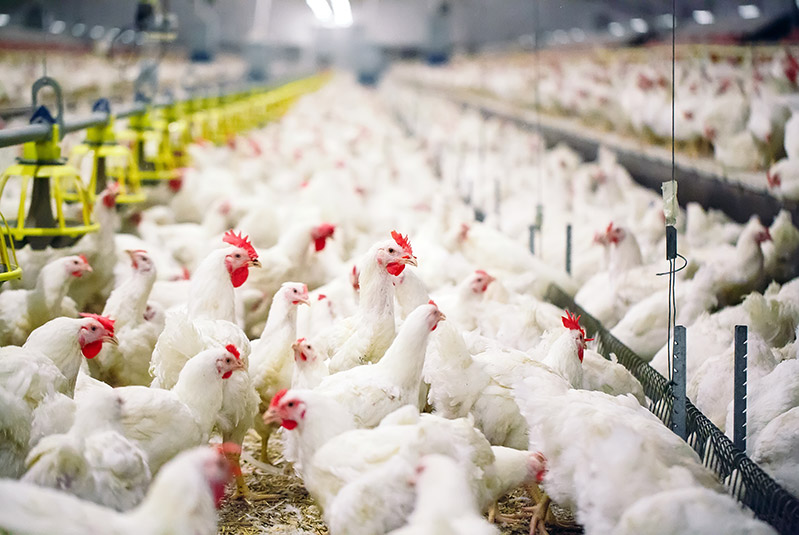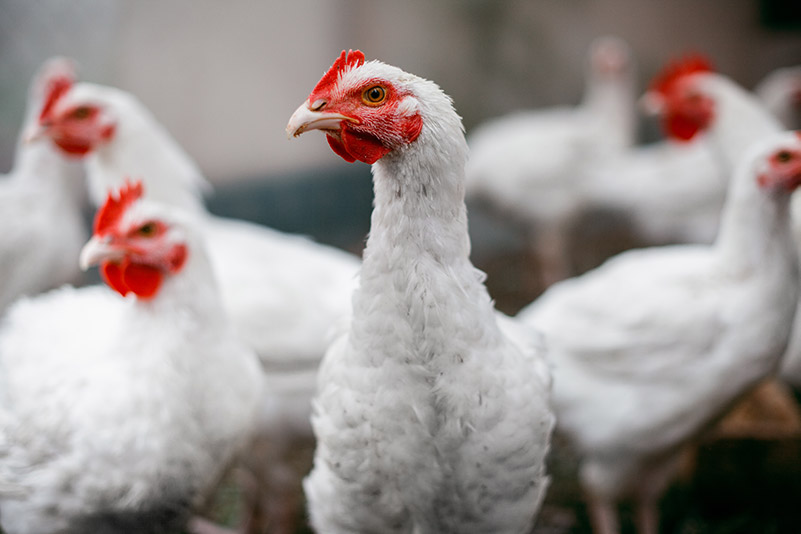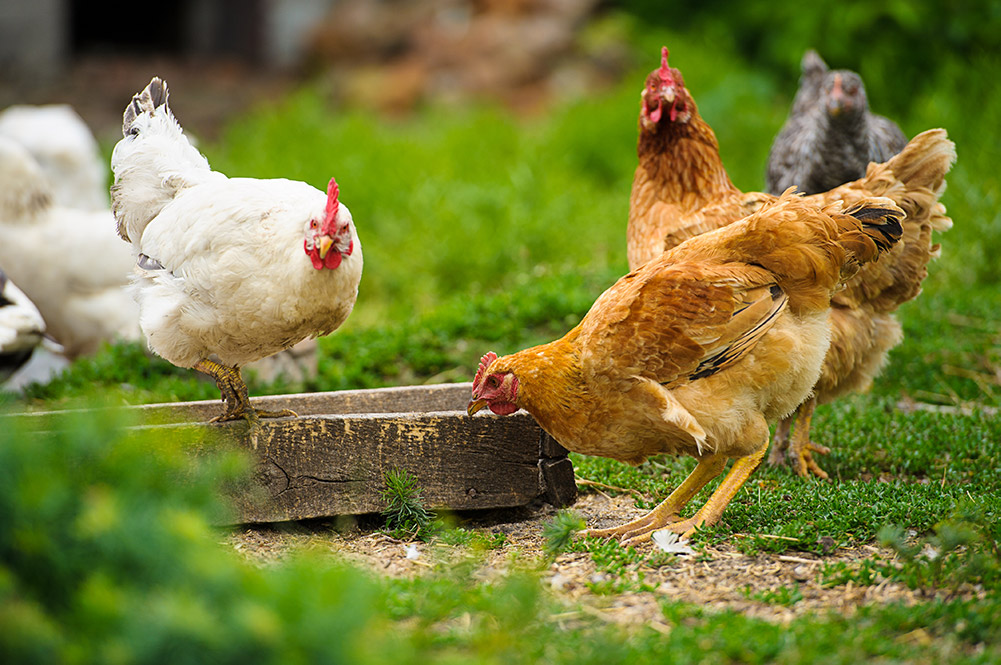Section 4 | Prevention Strategies for Coccidiosis
Industry
Page 24 /
Healthy Environments = Healthy Birds
Eradication of Eimeria from poultry housing is not reasonably possible. Because of this, management practices should be aimed at reducing the numbers of Eimeria that the birds are exposed to, as well as maximize the immunity and immune function of your flock so as not to overwhelm their immune system (recall the epidemiological triad of host, agent, and environment).
The process in which coccidia become infective depends on:
Adequate temperature
- A higher initial environmental temperature when birds are being placed in the barn can reduce the risk of finding intestinal lesions associated with coccidia1 on post mortem examination
Presence of moisture
- Wet litter accelerates the sporulation of coccidia, causing increased proliferation. Litter humidity should be 50-55% depending on whether you use straw or shavings
- Strategies aimed at reducing litter moisture levels and maintaining optimal environmental conditions is critical to preventing the buildup of coccidia. Adequate ventilation and leak-free watering systems are important to prevent wet litter which will reduce the survivability of coccidia in the environment (not to mention bacteria, too!)
- Humidity is also an important component in the development of Eimeria, which is why ventilation is critically important to manage
- Keep relative humidity between 35-70%
Oxygen access
- Limiting the amount of oxygen access through the accumulation and compaction of litter will also prevent the development of coccidia
- Proliferation of oocysts seems to be higher in winter when ventilation in most broiler barns is reduced because of cold outside temperatures
For an excellent resource of placing and raising healthy birds upon arrival, check out this resource by Dr. Martine Bouilianne and her team of researchers at the University of Montreal:
Chick Champs
Available in both English and French
Ask the expert:
Canadian poultry researchers stress the importance of the role the environment has in developing a bird’s gut microbiota from placement. Gut microbiota evolves from factors of environmental cleanliness and condition, conditions at the hatchery, and could be inherited. While producers may not have a role in all stages of bird growth and development, ensuring a clean, well ventilated, warm, dry environment can have significant impacts on establishing and maintaining gut health. This, in turn, can influence the development of coccidiosis and necrotic enteritis!
)
Litter
Larger amounts and deeper bedding have also been found to be associated with a higher number of intestinal lesions due to coccidiosis. It is recommended to replace litter between successive poultry flocks to decrease the number of oocytes that are found in the environment1. This will prevent new, young birds being exposed to the pathogens of the previous birds that may have had better capacity or immunity to manage exposure.
Back to the Biosecurity Basics
Biosecurity measures that limit human access to poultry facilities is also another important consideration, and should be strictly employed on every operation. Coccidia is a very hardy parasite and can last as long as 2 years in the environment under the right conditions.
Ensure that personnel that are coming into the barn:
- Wear clean boots and coveralls
- Use equipment that is specific to the barn
- Equipment is cleaned between uses and flocks
These will help reduce the spread of coccidia oocysts and can aid in preventing birds from being infected. Check out the FAAST team’s page, Improving Biosecurity on the Farm, for more information.
In addition to the factors mentioned above, good general barn practices will help to control and prevent coccidiosis from impacting your flock:
Clean and disinfect
- Equipment and housing, especially between crops of birds. More work is necessary to demonstrate the specific disinfectants that can reduce the burden of coccidiosis, however, in a laboratory setting there are disinfectants that are commercially available that have been shown to destroy coccidia2
Check anterooms
- Ensure the cleanliness of rooms between animal holding areas. If areas where boots, coveralls, and equipment is not kept clean, bacteria and other pathogens will be spread to other areas of the barn
Ask the expert:
One strategy a Canadian poultry expert suggested to ensure equipment and clothing compliance between barns is to provide and designate different coloured boots (as well as mark coveralls and equipment with different coloured tape, etc.) for each barn or area of the barn. It will be very easy to identify anyone that is not following the rules!
Ensure biosecurity is maintained by everyone who enters the barn. Complacency can have devastating consequences!
Revisit your prep for the next crop
- Longer times between successive flocks and allowing time for the barn to dry thoroughly will reduce the number of viable coccidia oocysts that are able to infect newly incoming chicks
Start your chicks off right
- Ensuring that feed and water is readily available when chicks are placed, and proper heat, ventilation, lighting, and feed and water quality are present can go a long way to helping birds resist this disease
Control rodents
- Rodents can be major reservoirs of bacteria and other diseases. Be sure to keep rodents out where possible, and ensure that manure is not stored within ~400 feet of the barn
Ask the expert:
Some key performance indicators as identified by a nutritionist, and veterinarians include close monitoring of flocks and attention to detail. This includes monitoring the flock for feed and water intake, checking humidity and temperature in the barn daily, address spikes in mortality (particularly around 18-23 days of age) and performing post mortem exams to identify the cause of illness. Without the use of preventative antimicrobials, producers must be on top of their barn management game; we can no longer use antimicrobials as a crutch to overcome improper or reduced barn management. With good management, the removal of Category III antimicrobials will not be an insurmountable obstacle for the industry.
Key aspects of flock monitoring might include:
Brooding
- Calculate feed, and plan for 65 g of feed per chick being placed
- Check crops of birds after 24 hours of placement, 95% of birds should have feed in their crops
- Check cloacal temperature of a group of birds, ideally they should be 40.0-40.7°C
Housing and ventilation
- Checking temperature, humidity and litter cleanliness daily. Aim for 32- 34°C and heat barns for 2-3 days before chick placement
- Adjust ventilation to maintain a humidity of 70%
Coccidia control
- Use an anticoccidial protocol developed with your veterinarian. This will also help to control necrotic enteritis!
Check out some video resources by the Chicken Farmers of Canada on brooding management for broilers. These videos feature checking temperature, chick placement, and lighting:
)
Nothing Beats Good Management
We know that vaccination and the provision of anticoccidial medications are keys to ensuring the continued health and success of your flock, but they cannot overcome the importance of good management. Ensuring your barn is clean, drinkers and feeders are in good working order, and birds’ exposure to manure and oocysts is as minimal as possible. Of course, solutions will vary on each farm, and ultimately, a combination of management practices will result in success.
Ask the expert:
Don’t rush down time! Canadian poultry experts can’t stress enough the importance of maintaining a good period of down time between crops. The U.S. has good success with 3 weeks between crops. Reducing down time may allow some extra birds through the barn every year, but at what cost does this come? Reducing time between crops can offset the benefit of having more birds through performance losses, treatment costs, and veterinary costs. Exposing them to oocysts and other pathogens will only start chicks off at a disadvantage. With such a short growing period, these setbacks become difficult to overcome.
Check out this resource from the Chicken Farmers of Canada for reducing coccidiosis as a means of thereby reducing the incidence of necrotic enteritis: Coccidiosis control, litter management key to NE prevention in broilers raised without antibiotics. Another great resource on environmental management with practical tips can be found here: Producers Need to Focus on Eimeria Oocysts.
The FAAST team also has recommendations for best management practices in the Antimicrobial Stewardship FAAST Review, specifically, the page entitled Key Aspects of Animal Husbandry.
References:
- Henken, A.M., J.O. Goelema, F. Neijenhuis, M.H. Vertommen, J. Van Den Bos, and C. Fris. 1992. Multivariate epidemiological approach to coccidiosis in broilers. Poultry Science. 71:1849-1856.
- Williams, R.B. 1997. Laboratory tests of phenolic disinfectants as oocysticides against the chick coccidium Eimeria tenella. Vet Rec. 141:447-448.
